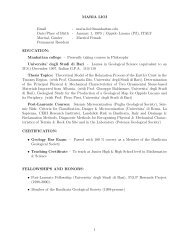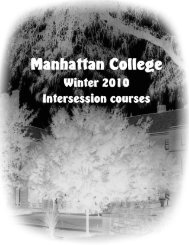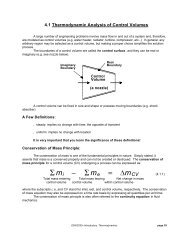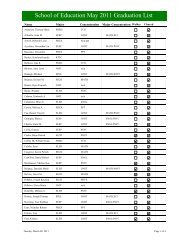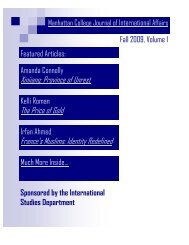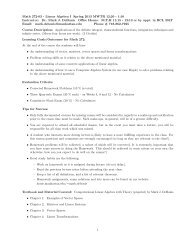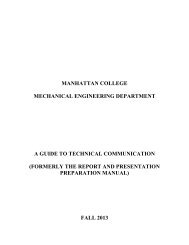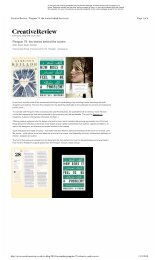Flexibility in timing of molting of fiddler crab ... - Inter Research
Flexibility in timing of molting of fiddler crab ... - Inter Research
Flexibility in timing of molting of fiddler crab ... - Inter Research
You also want an ePaper? Increase the reach of your titles
YUMPU automatically turns print PDFs into web optimized ePapers that Google loves.
MARINE ECOLOGY PROGRESS SERIESMar Ecol Prog SerPublished January 30<strong>Flexibility</strong> <strong>in</strong> tim<strong>in</strong>g <strong>of</strong> molt<strong>in</strong>g <strong>of</strong> <strong>fiddler</strong> <strong>crab</strong>megalopae: evidence from <strong>in</strong> situmanipulation <strong>of</strong> cuesNancy J. onnor nor'^', Michael L. ~udge~'Department <strong>of</strong> Biology, University <strong>of</strong> Massachusetts Dartmouth, N. Dartmouth, Massachusetts 02747-2300, USA'Department <strong>of</strong> Biology, Manhattan College, Riverdale, New York 10471, USAABSTRACT: Rather than rely<strong>in</strong>g on chance delivery <strong>of</strong> larvae to experimental field substrata, we developeda field cag<strong>in</strong>g method to expose lab-reared <strong>crab</strong> megalopae to natural cues that could affect tim<strong>in</strong>g<strong>of</strong> molt<strong>in</strong>g to the first <strong>crab</strong> stage. Uca pugnax megalopae were placed <strong>in</strong> plastic mesh cages conta<strong>in</strong><strong>in</strong>gfreshly collected sediments from a marsh occupied by U. pugnax, or similar sediments that hadbeen combusted to remove organic material. Cages <strong>of</strong> each sediment type were placed at identical tidalelevations <strong>in</strong> a Spart<strong>in</strong>a alterniflora marsh for 1 or 3 d <strong>of</strong> exposure to natural seawater. Significantlymore megalopae molted <strong>in</strong> cages conta<strong>in</strong><strong>in</strong>g fresh than combusted marsh sediments (90% vs 32%.ANOVA F,,,= 53.95, p < 0.001) after a 3 d penod <strong>of</strong> exposure. Three days after the 1 d exposure period.nearly all megalopae from cages <strong>of</strong> both sediment types had molted. Furthermore, all sibl<strong>in</strong>g megalopaerema<strong>in</strong><strong>in</strong>g In the lab dur<strong>in</strong>g the field experiment fa~led to molt. High rates <strong>of</strong> molt<strong>in</strong>g <strong>of</strong> megalopaecaged <strong>in</strong> the marsh w~th natural and combusted sediments <strong>in</strong>d~cate that chemical substancesboth <strong>in</strong> the water overly<strong>in</strong>g the marsh and associated with marsh sediments stimulated molt<strong>in</strong>g <strong>of</strong>megalopae.KEY WORDS: Fiddler <strong>crab</strong> . Uca pugnax. Larvae . Molt<strong>in</strong>g . Chemical cuesINTRODUCTION<strong>Research</strong> on settlement and metamorphosis <strong>of</strong> decapodpostlarvae has documented a behavioral response<strong>of</strong> postlarvae to cues <strong>in</strong> the field, evidenced by preferentialsettlement <strong>in</strong> certa<strong>in</strong> areas, and a physiologicalresponse to cues <strong>in</strong> the lab, evidenced by earlier molt<strong>in</strong>gto the benthic stage <strong>in</strong> the presence <strong>of</strong> certa<strong>in</strong> cues.Dur<strong>in</strong>g settlement <strong>in</strong> the field, decapod postlarvae<strong>of</strong>ten respond to particular habitat features. For example,sp<strong>in</strong>y lobster postlarvae prefer to settle <strong>in</strong> clumps<strong>of</strong> branched red algae (Herrnk<strong>in</strong>d & Butler 1986), Dungeness<strong>crab</strong> megalopae settle <strong>in</strong> higher numbers ontobivalve shell debris than onto sediments (Fernandez etal. 1993, Eggleston & Armstrong 1995), and newly settledblue <strong>crab</strong> megalopae are found <strong>in</strong> greater abun-dance with<strong>in</strong> seagrass beds or <strong>in</strong>tertidal marshes than<strong>in</strong> unvegetated areas (Orth & van Montfrans 1987,Mense & Wenner 1989). Fiddler <strong>crab</strong> megalopae settle<strong>in</strong> salt marshes but not adjacent tidal flats, and arefound <strong>in</strong> greater abundance <strong>in</strong> areas <strong>in</strong>habited byolder conspecifics (O'Connor 1993).Habitat characteristics may also affect the tim<strong>in</strong>g <strong>of</strong>metamorphosis. In the laboratory, <strong>fiddler</strong> <strong>crab</strong> megalopaemolt to the first <strong>crab</strong> stage sooner <strong>in</strong> the presence<strong>of</strong> particular habitat components. Uca pugilator megalopaerespond (by molt<strong>in</strong>g earlier) to sediments collectednear adult burrows (Christy 1989) or to naturalsediments ma<strong>in</strong>ta<strong>in</strong>ed with adult <strong>crab</strong>s (O'Connor1991). Uca pugnax megalopae molt <strong>in</strong> response tochemicals released by adults, but not to mock sediments(silt-sized glass beads) that were ma<strong>in</strong>ta<strong>in</strong>ed <strong>in</strong>the presence <strong>of</strong> adult <strong>crab</strong>s (O'Connor & Greggunpubl.). Yet we do not know how megalopae respondphysiologically, by molt<strong>in</strong>g, <strong>in</strong> response to natural cues<strong>in</strong> the field.0 <strong>Inter</strong>-<strong>Research</strong> 1997Resale <strong>of</strong> full article not permitted
56 Mar Ecol Prog Ser 146: 55-60, 1997We have developed and tested a method to placeequal numbers <strong>of</strong> sibl~ng, laboratory-reared larvae <strong>in</strong>tothe field, enclosed <strong>in</strong> mesh cages, for exposure to differenttypes <strong>of</strong> potential habitat cues. The methodfacilitates easy retrieval <strong>of</strong> cages and subsequent exam<strong>in</strong>ation<strong>of</strong> enclosed animals. Other advantages <strong>of</strong>our method are that the larvae have had no prior exposureto natural cues <strong>in</strong> the field, they have been rearedunder identical conditions, they are <strong>of</strong> known ages andcompetent to settle and metamorphose, and we do nothave to rely on chance transport <strong>of</strong> larvae to experimentalsubstrata. In addition, the responses <strong>of</strong> larvae tocomplex cues <strong>in</strong> the field can be compared directlywith those <strong>of</strong> larvae exposed to s<strong>in</strong>gle cues <strong>in</strong> the laboratory.The present study exam<strong>in</strong>ed the effects <strong>of</strong> 2 potentialhabitat cues on tim<strong>in</strong>g <strong>of</strong> molt<strong>in</strong>g <strong>of</strong> Uca pugnax megalopae<strong>in</strong> the field. The first cue was the natural seawateroverly<strong>in</strong>g the surface <strong>of</strong> a salt mdrsh <strong>in</strong>habited by Lipugnax (represent<strong>in</strong>g waterborne cues). The secondcue was the sedirnents freshly collected from the marshsurface (= benthic cues). Although both cues ~ndlviduallyaffected the tim<strong>in</strong>g <strong>of</strong> molt<strong>in</strong>g, the greatest responseto these complex habitat cues occurred whenwaterborne and benthic cues were comb<strong>in</strong>ed.MATERIALS AND METHODSLarval culture. Larvae used <strong>in</strong> the experiments werereleased by ovigerous female Uca pugnax collectedfrom the Slocums River estuary <strong>in</strong> S. Dartmouth, Massachusetts,USA (sal<strong>in</strong>ity approx. 30) <strong>in</strong> June 1995.Additional larvae were obta<strong>in</strong>ed from <strong>crab</strong>s that werema<strong>in</strong>ta<strong>in</strong>ed <strong>in</strong> the laboratory and periodically checkedfor the presence <strong>of</strong> eggs. Ovigerous <strong>crab</strong>s were placed<strong>in</strong>dividually <strong>in</strong> 11.5 cm glass culture dishes with-200 m1 filtered (0.45 pm) seawater diluted with deionizedwater to a sal<strong>in</strong>ity <strong>of</strong> 25 (= FSW), to which theantibiotics sodium penicill<strong>in</strong> G (21.9 mg I-') and streptomyc<strong>in</strong>sulfate (36.5 mg 1-l) were added. Each morn<strong>in</strong>gthe dishes were checked for the presence <strong>of</strong> larvae.If larvae had not hatched, the ovigerous females weretransferred to a clean bowl with fresh FSW and antibiotics.The <strong>crab</strong>s were not fed.Newly released sibl<strong>in</strong>g zoeae were placed <strong>in</strong> groups<strong>of</strong> -40 <strong>in</strong> each <strong>of</strong> 3 or 4 culture dishes (diam. 11.5 cm).Each dish conta<strong>in</strong>ed -175 m1 <strong>of</strong> FSW and ant~blotics.The zoeae were <strong>of</strong>fered the rotifer Brachionuspllcatilisand newly hatched br<strong>in</strong>e shrimp nauplii (Arternla sp.)as food. As the zoeae molted to later stages, the proportion<strong>of</strong> rotifers <strong>in</strong> their diet was decreased, and that<strong>of</strong> Artemia was <strong>in</strong>creased. By the time they reachedthe fourth zoeal stage, the larvae were fed br<strong>in</strong>eshrimp only. Each day the larvae were transferred to aclean dish with fresh FSW and antibiotics, and foodwas added. The number <strong>of</strong> deaths was noted, and theproportion <strong>of</strong> Individuals molt<strong>in</strong>g (evidenced by thepresence <strong>of</strong> exuviae) was approximated Mortal~ty wasgenerally very low (15%), and larvae tended to moltsynchronously. Both ovigerous females and larval cultureswere ma<strong>in</strong>ta<strong>in</strong>ed <strong>in</strong> an environmental chamber(26°C k 1°C, 14 h light: l0 h dark photoperiod).After molt<strong>in</strong>g to the megalopa stage (usually after 11to 13 d <strong>of</strong> larval life), the larvae were cultured <strong>in</strong>groups <strong>of</strong> 25 to 80 <strong>in</strong> 20 cm glass culture dishes conta<strong>in</strong><strong>in</strong>g600 rnl FSW, antibiotics, and Arternja nauplii.Megalopae were transferred and fed each day. Sixdays after they had molted to the megalopa stage,megalopae were transferred to the field site.Cage design. Cyl<strong>in</strong>drical cages (10 cm height X8.8 cm width) were used for field deployment <strong>of</strong> labrearedlarvae. The base <strong>of</strong> the cage consisted <strong>of</strong> thebottom portion (8.8 cm width x 1.4 cm height] <strong>of</strong> a polystyrenepetri dish (Baxter D1906). The sides and top <strong>of</strong>the cages were made <strong>of</strong> 300 pm nylon mesh. The topconta<strong>in</strong>ed a flap that opened halfway to allow addition<strong>of</strong> megalopae <strong>in</strong> the field. All seams <strong>of</strong> the cage wereglued with 100% silicone sealant (G.E. #012). A 15 cmmild steel (high carbon) stake was glued to the outside<strong>of</strong> the bottom <strong>of</strong> the petri dish to secure the cage <strong>in</strong>benthic sediments <strong>in</strong> the field.Field site. The field site was a marsh consist<strong>in</strong>g <strong>of</strong>Spart<strong>in</strong>a alterniflora and Salicornia europaea grow<strong>in</strong>g<strong>in</strong> muddy sand sediments (75Y0 particles >63 pm),located <strong>in</strong> Dernarest Lloyd State Park near the mouth<strong>of</strong> the Slocums River estuary <strong>in</strong> Dartmouth, ~Massachusetts,USA (41" 31' N, 70" 59' W). The marsh conta<strong>in</strong>ednumerous burrows occupied by the <strong>fiddler</strong> <strong>crab</strong> Ucapugnax.Treatments and cage deployment. Cages conta<strong>in</strong>ed15 m1 <strong>of</strong> sediments <strong>of</strong> 1 <strong>of</strong> 2 types: (1) surface (-0.5 cmdepth) marsh sediments freshly collected near <strong>fiddler</strong><strong>crab</strong> burrows (= fresh marsh sediments treatment), and(2) identical marsh sediments that had been dried andcombusted <strong>in</strong> a muffle furnace (550 to 600°C for 2 h) tooxidize organic material (= muffled marsh sedimentstreatment). Large detrital fragments and pebbles wereremoved from both sediment types. Both sedimenttypes were placed <strong>in</strong> cages <strong>in</strong> the field just before addition<strong>of</strong> larvae.With<strong>in</strong> the marsh, a transect parallel to the shore wasestablished at a tidal height <strong>of</strong> 0.9 m, the elevation <strong>of</strong>the marsh where <strong>crab</strong>s were abundant. Ten cages,each separated by 50 cm, were placed along the transect.Cages alternated between fresh and muffled sedimenttypes. All cages <strong>in</strong> the marsh were 23 m <strong>in</strong>to thevegetated habitat.Experiments began 6 d after the <strong>fiddler</strong> <strong>crab</strong> larvaehad reached the rnegalopa stage. In the first experi-
O'Connor &Judge: Molt<strong>in</strong>g <strong>of</strong> <strong>fiddler</strong> <strong>crab</strong> megalopae 5 7ment, cages were deployed on 13 July and retr~evedon 14 July 1995 (20 h <strong>in</strong> the field with-10 h <strong>of</strong> submersion; = l-day deployment, Fig. 1).The second experiment took place from 14 July to17 July 1995 (70 h <strong>in</strong> the field with -28 h <strong>of</strong> submersion;= 3-day deployment).Six-day old megalopae pooled from 3 differentbroods were divided <strong>in</strong>to groups <strong>of</strong> 10 and placed<strong>in</strong> 12 m1 <strong>of</strong> FSW (sal<strong>in</strong>ity = 25) <strong>in</strong> polypropylenecentl-ifuge tubes for transport to the fleld siteSome Artemia naupl~i were added to prov~de foodfor the megalopae. Megalopae were <strong>in</strong>troduced<strong>in</strong>to each cage dur<strong>in</strong>g late afternoon -3 h prior tosubmersion by the <strong>in</strong>com<strong>in</strong>g tide. Megalopaewere r<strong>in</strong>sed from the centrifuge tube <strong>in</strong>to the cageus<strong>in</strong>g sieved, field-collected seawater. The open<strong>in</strong>gat the top <strong>of</strong> the cage was then sealed w~thsilicone.Cages were monitored dur<strong>in</strong>g daylight hours.One <strong>of</strong> the fresh sediment cages <strong>in</strong> the marsh wasdis~laced -0.5 m landward and reanchored on thesecond day <strong>of</strong> the 3-day deployment. B~~~~~~ airtemperatures ranged from 20°C at night to 32°Cdur<strong>in</strong>g the day, additional seawater was added tocages <strong>of</strong> the 3-day deployment after 48 h. Daytimewater temperature <strong>in</strong> the vic<strong>in</strong>ity <strong>of</strong> the field site, however,never exceeded 26°C. Sal<strong>in</strong>ity <strong>of</strong> water at the sitewas -28 to 30.Laboratory observations. Sixteen sibl<strong>in</strong>gs <strong>of</strong> themegalopae used <strong>in</strong> the 3-day deployment were ma<strong>in</strong>ta<strong>in</strong>edsimultaneously <strong>in</strong> the laboratory In a 11.5 cmculture dish conta<strong>in</strong><strong>in</strong>g FSW (sal<strong>in</strong>ity = 25) with antibiotics.Each day the number <strong>of</strong> <strong>in</strong>dividuals that hadmolted to the first <strong>crab</strong> stage was noted. The rema<strong>in</strong><strong>in</strong>gmeglaopae were transferred to a clean dish with freshFSW and Artemia.Subsequent to the field deployments, the effect onmoltlng time <strong>of</strong> muffled sediments as a potential tactilecue was exam<strong>in</strong>ed <strong>in</strong> the laboratory. Four daysafter molt<strong>in</strong>g to the megalopa stage, larvae wereplaced <strong>in</strong>dividually <strong>in</strong>to 60 X 15 mm sterile polystyrenepetri dishes conta<strong>in</strong><strong>in</strong>g 10 m1 FSW or 10 m1FSW plus 0.5 m1 muffled sediments from the samestock used <strong>in</strong> the field experiments. Twenty megalopaewere tested <strong>in</strong> each treatment. Several Artemianauplii were added as food for the megalopae. Eachday the number <strong>of</strong> <strong>in</strong>dividuals molt<strong>in</strong>g to the first <strong>crab</strong>stage was noted, and megalopae were transferred tonew dishes conta<strong>in</strong><strong>in</strong>g fresh treatments every otherday.Data analysis. The proportion molt<strong>in</strong>g to the first<strong>crab</strong> stage with<strong>in</strong> each replicate cage was the responsevariable. After arcs<strong>in</strong>e transformation, the varianceswere found not to differ significantly from homogeneity(Bartlett's test = 0.47, p = 0.52). Data from each fieldPredicted Tidal Series, July 1995l -day3-day1.8 deployment deploymentl3 Jbly 14 July 15 July 16 July 17 JulyDateFig. 1. Tidal series at the field site dunng the l-day (vert~cal dashedl<strong>in</strong>es) and the 3-day (vertical solid l<strong>in</strong>es) deployment study periods.Tidal heights were calculated from the predicted tidal levels forNewport. Rhode Island, USA (NOAA 1995) and adjusted frommeasurements conducted at the site. The horizontal dotted l<strong>in</strong>e<strong>in</strong>dicates the tidal height <strong>of</strong> the experimental cages. Megalopaewere submerged by the tide 47 5% <strong>of</strong> the time dur<strong>in</strong>g the l-dayand 39.7 % dur<strong>in</strong>g the 3-day deploymentdeployment were analyzed via l-way ANOVA withsediment as the ma<strong>in</strong> effect.The effect <strong>of</strong> the presence <strong>of</strong> muffled sediments ontim<strong>in</strong>g <strong>of</strong> molt<strong>in</strong>g <strong>in</strong> the lab was analyzed by compar<strong>in</strong>gthe median day <strong>of</strong> molt<strong>in</strong>g <strong>of</strong> megalopae <strong>in</strong> eachtreatment us<strong>in</strong>g the non-parametric Mann-Whitney U-test, due to the non-normal distribution <strong>of</strong> the data.RESULTSVery few megalopae molted to the first <strong>crab</strong> stagedur<strong>in</strong>g the l-day deployment <strong>in</strong> the marsh habitat: anaverage <strong>of</strong> 2% molted <strong>in</strong> cages with the muffled sedimentand 0% <strong>in</strong> the fresh sediment treatments (Fig. 2).However, after 3 d <strong>in</strong> the marsh, significantly moremegalopae molted <strong>in</strong> cages conta<strong>in</strong><strong>in</strong>g the fresh sedimenttreatment (Fig. 2; mean proportion + SD = 0.90 +0.07) than <strong>in</strong> the muffled sediment treatment (0.32 +0.11) (ANOVA, = 53.95, p < 0.001). Survivorship <strong>of</strong>megalopae <strong>in</strong> cages <strong>in</strong> the marsh habitat was veryhigh: 90 to 100% <strong>in</strong> each cage survived the l-day and3-day deployment periods.Megalopae from the fresh and muffled sedimentcages placed <strong>in</strong> the marsh for the l-day deploymentwere removed from the cages at the end <strong>of</strong> the deployment,and held <strong>in</strong> a plastic conta<strong>in</strong>er conta<strong>in</strong><strong>in</strong>g FSW<strong>in</strong> the laboratory. One day after removal from themarsh, only -10% had molted to first <strong>crab</strong>. Three daysafter field exposure, however, 80 to 90% <strong>of</strong> the mega-
Mar Ecol Prog Ser 146: 55-60, 1997E4l-day3-dayIn the laboratory, the presence <strong>of</strong> muffled marsh sediment~had no effect on tim<strong>in</strong>g <strong>of</strong> molt<strong>in</strong>g (Mann-WhitneyU-test, p = 0.43). The median day <strong>of</strong> molt<strong>in</strong>g <strong>of</strong>megalopae <strong>in</strong> dishes with FSW was 12 0 (mean = 13.8,SD = 6.9), and <strong>in</strong> dishes with both FSW and muffledsediment it was 12.5 d (mean = 14.6, SD = 10.1). Thissuggests that the muffled sediments did not provide atactile cue for molt<strong>in</strong>g <strong>in</strong> the field.MuffledSediment TypeFreshFig. 2. Uca pugnax. Proportion (mean i SD) <strong>of</strong> <strong>fiddler</strong> <strong>crab</strong>megalopae molt<strong>in</strong>g to first <strong>crab</strong> stage with<strong>in</strong> marsh (Spart<strong>in</strong>aalterniflora) habitats dur<strong>in</strong>g 2 field deployments. Althoughproportion molt<strong>in</strong>g dur<strong>in</strong>g the l-day deployment did not differbetween sediment treatments, the proportion molt<strong>in</strong>gwith<strong>in</strong> 5 replicate cages dur<strong>in</strong>g the 3-day deployment wassignificantly greater (ANOVA on arcs<strong>in</strong>e-transformed data,F,,, = 53.95, p < 0.001) for sediment freshly collected fromnearby <strong>fiddler</strong> <strong>crab</strong> burrows than similar sediment that hadbeen previously combusted <strong>in</strong> a muffle furnace (2 to 3 h at550 to 600°C). Survivorship <strong>of</strong> ~ndividuals was greater than90% dur<strong>in</strong>g both deploymentsDays S<strong>in</strong>ce Experiment BeganFig. 3. Uca pugnax. Cumulative molt<strong>in</strong>g frequency <strong>of</strong> <strong>fiddler</strong><strong>crab</strong> megalopae ma<strong>in</strong>ta<strong>in</strong>ed <strong>in</strong> the laboratory without fieldcues. Sixteen 6-day-old megalopae from the same broods utlllzedIn the field expenment were scored daily for numbermoltlng to <strong>crab</strong> 1, commenc<strong>in</strong>g with ~nitiation <strong>of</strong> the 3-daydeployment. The correspond~ng mean molt<strong>in</strong>g percentage Inthe field dur<strong>in</strong>g the 3-day deployment is <strong>in</strong>dicated by 'F'(fresh sediment) and 'M' (muffled sediment)lopae molted to the first <strong>crab</strong> stage, which is comparableto the percentage molt<strong>in</strong>g dur<strong>in</strong>g the 3-day period<strong>of</strong> exposure to natural cues <strong>in</strong> the field.Megalopae ma<strong>in</strong>ta<strong>in</strong>ed <strong>in</strong> the laboratory molted farmore slo~vly than their sibl<strong>in</strong>gs <strong>in</strong> the field. At the end<strong>of</strong> the 3-day field deployment, none <strong>of</strong> the specimens<strong>in</strong> the lab had molted to the first <strong>crab</strong> stage (Fig. 3).Even 1 wk after the field experiment ended, only 19%<strong>of</strong> the megalopae <strong>in</strong> the lab had molted.DISCUSSIONOur short-term field experiment provides strong evidencethat natural cues greatly affect metamorphosis(molt<strong>in</strong>g) <strong>of</strong> <strong>crab</strong> megalopae, by <strong>in</strong>duc<strong>in</strong>g molt<strong>in</strong>gbetween 1 and 3 d after <strong>in</strong>itial exposure. Both naturalseawater overly<strong>in</strong>g a marsh and natural marsh sedimentsdramatically affected tim<strong>in</strong>g <strong>of</strong> molt<strong>in</strong>g, comparedto molt<strong>in</strong>g <strong>of</strong> sibl<strong>in</strong>g megalopae ma<strong>in</strong>ta<strong>in</strong>ed <strong>in</strong>the laboratory. In fact, the magnitude <strong>of</strong> the response,as <strong>in</strong>dicated by proportion rnolt<strong>in</strong>g, was greater thanthat seen <strong>in</strong> laboratory experiments (O'Connor 1991,O'Connor & Gregg unpubl.). However, Christy (1989)also observed that sediments collected adjacent toadult burrows stimulated substantially earlier molt<strong>in</strong>g<strong>of</strong> Uca pugilator megalopae <strong>in</strong> the lab. The dramaticresponse <strong>of</strong> larvae to cues <strong>in</strong> the field compared withmolt<strong>in</strong>g <strong>of</strong> sibl<strong>in</strong>gs <strong>in</strong> the lab (Fig. 3) strongly suggeststhat larvae <strong>in</strong> the lab were <strong>in</strong> fact delaylng metamorphosis(Pechenik 1990), rather than simply develop<strong>in</strong>gat a slower rate. Even though daytime air temperatures<strong>in</strong> the field became rather high, average water temperaturewas similar to that <strong>in</strong> which megalopae <strong>in</strong> thelaboratory were ma<strong>in</strong>ta<strong>in</strong>ed. Therefore, temperaturedifferences between the laboratory and the field werenot great, and probably did not accelerate molt<strong>in</strong>g <strong>of</strong>rnegalopae <strong>in</strong> the field.The question arises as to the identity <strong>of</strong> the cues <strong>in</strong>nature. Two types <strong>of</strong> cues were important <strong>in</strong> stimulat<strong>in</strong>gmolt<strong>in</strong>g: cues <strong>in</strong> the water and cues associated withbenthic sediments. Water-soluble cues could havebeen derived from benthic sediments, marsh grass, oradult <strong>fiddler</strong> <strong>crab</strong>s <strong>in</strong>habit<strong>in</strong>g the marsh. Marsh grass isan unlikely cue, based on test<strong>in</strong>g <strong>of</strong> leachates fromSpart<strong>in</strong>a <strong>in</strong> the laboratory (O'Connor & Greggunpubl.). It is likely that soluble cues from either conspecificadults or natural marsh sedirnents, or both,were effective <strong>in</strong> stimulat<strong>in</strong>g molt<strong>in</strong>g. In laboratorystudies, cues derived from adult <strong>crab</strong>s significantlyaffect tim<strong>in</strong>g <strong>of</strong> molt<strong>in</strong>g <strong>of</strong> <strong>fiddler</strong> <strong>crab</strong> larvae (Christy1989, O'Connor 1991, O'Connor & Gregg unpubl.). Inaddition, substances associated with natural marshsedirnents, rather than sediment particles themselves,may represent a contact-dependent cue for megalopae.Sediments without natural organisms and mole-
O'Connor & Judge- Molt<strong>in</strong>g <strong>of</strong> f~ddler <strong>crab</strong> megalopae 59cules (i.e. muffled marsh sediments <strong>in</strong> FSW) were noteffective at stimulat<strong>in</strong>g molt<strong>in</strong>g <strong>in</strong> the laboratory.Blue <strong>crab</strong> megalopae also molt sooner when exposedto potential habitat cues <strong>in</strong> the laboratory. Megalopalmolt<strong>in</strong>g is advanced by exposure to estuar<strong>in</strong>e seawatercompared with <strong>of</strong>fshore seawater (Wolcott & De Vries1994), and soluble materials leached from seagrassesare particularly effective at stimulat<strong>in</strong>g molt<strong>in</strong>g (Forwardet a1 1994, 1996). The present study providesadditional evidence that <strong>crab</strong> megalopae molt <strong>in</strong>response to chemical cues derived from adult habitats.Benthic <strong>in</strong>vertebrate larvae are known to utilize avariety <strong>of</strong> environmental cues to locate and metamorphose<strong>in</strong> suitable adult habitat. Hydrodynamic processes<strong>in</strong>fluence larval delivery and behavior at a variety<strong>of</strong> spatial scales (Eckman et al. 1983, Butman 1987).Surface characteristics may also serve as importanttactile cues for larvae (Rittsch<strong>of</strong> et al. 1984, Wethey1986). There is ample evidence that larvae activelyexplore such surfaces after contact (Mull<strong>in</strong>eaux & Butman1991, Walters 1992). In addition to their welldocumentedrole <strong>in</strong> crustacean b~ology, chemlcal cueshave been shown important <strong>in</strong> many benthlc groups,<strong>in</strong>clud<strong>in</strong>g polychaetes (Pawlik et al. 1991) and bivalves(Turner et al. 1994), even under simulated natural flowregimes. While we are not able to rank the relativeimportance <strong>of</strong> these cues <strong>in</strong> the present study, thestrong differential response under field cond~tions toour manipulations suggests that chemical cues are criticalto the settl<strong>in</strong>g larvae <strong>of</strong> benthic <strong>in</strong>vertebrates.The present study represents a new approach to thestudy <strong>of</strong> cues stimulat<strong>in</strong>g metamorphosis <strong>of</strong> <strong>in</strong>vertebratelarvae. The cag<strong>in</strong>g technique allows control <strong>of</strong>larval age at exposure to cues, and manipulation <strong>of</strong> thesource <strong>of</strong> the cues to which they are exposed. Our technlquealso ensures that equal numbers <strong>of</strong> larvae areexposed to different potential habitat cues. Other fieldexperiments, primarily deal<strong>in</strong>g with larval choice <strong>of</strong> settlementsite, rely on chance transport <strong>of</strong> planktonic larvaeto experimental sites, and must assume that larvaehave full access to different experimental substrata.Even <strong>in</strong> studies <strong>in</strong> which larvae are pelaglc for short periodsand can be tracked directly by human observers,e.g. relatively large ascidian larvae (Olson 1985, Stoner1990), researchers are unable to control larval abundanceor delivery to f~eld substrata The success <strong>of</strong> thepresent cag<strong>in</strong>g study should open new avenues <strong>of</strong> fieldexper~mentation on larval metamorphosis.Acknowledgenlents We are very grateful to our studentsAmanda Gregg, Kerry Cudmore McCarthy David Cnno, andDanlelle Cigliano for theii assistance <strong>in</strong> the laboratory and thefield We thank Richard B Foiward Jr, Jan Pechenik, and ananonymous reviewer for their comments on the manuscriptWe also thank the staff <strong>of</strong> Demarest Lloyd State Park forallow~ng us to set up our odd-look<strong>in</strong>g expeliment <strong>in</strong> the parkLlTERATURE CITEDButman CA (1987) Larval settlement <strong>of</strong> s<strong>of</strong>t-sediment <strong>in</strong>vertebrates,the spat~al scales <strong>of</strong> pattern expla<strong>in</strong>ed by actlvehabitat selection and the emerglng role <strong>of</strong> hydrodynamicalprocesses. Oceanogr Mar Biol A Rev 25:113-165Chr~sty JH (1989) Rapld development <strong>of</strong> megalopae <strong>of</strong> the <strong>fiddler</strong><strong>crab</strong> Uca pugilatorreared over sediment: implicationsfor models <strong>of</strong> larval recruitment. Mar Ecol Prog Ser 57.259-265Eckman JE (1983) Hydrodynamic processes affect<strong>in</strong>g benthicrecruitment. Limnol Oceanogr 28:241-257Eggleston DB. Armstrong DA (1995) Pre- and post-settlementdc,tei-m<strong>in</strong>ants <strong>of</strong> estuar<strong>in</strong>e Dungeness <strong>crab</strong> recruitmentEcol Monogr 65:193-216Fernandez M, Inbarne 0, Armstrong D (1993) Habitat selectionby young-<strong>of</strong>-the-year Dungeness <strong>crab</strong> Cancer maglsterand predation risk In <strong>in</strong>tertidal habitats Mar Ecol ProgSer 92:171-177Forward RB Jr, De Vries MC, Rittsch<strong>of</strong> D, Frankel DAZ,Bisch<strong>of</strong>f JP, Fisher CM, Welch JM (1996) Effects <strong>of</strong> environmentalcues on metamorphosis <strong>of</strong> the blue <strong>crab</strong> Calllnectessapidus Mar Ecol Prog Ser 131:165-177Forward RB Jr, Frankel DAZ, Rittsch<strong>of</strong> D (1994) Molt<strong>in</strong>g <strong>of</strong>megalopae from the blue <strong>crab</strong> Call<strong>in</strong>ectes sapldus: effects<strong>of</strong> <strong>of</strong>fshore and estuar<strong>in</strong>e cues Mar Ecol Prog Ser 113:55-59Heri-nk<strong>in</strong>d WF, Butler MJ IV (1986) Factors regulat<strong>in</strong>g postlarvalsettlement and juvenile microhab~tat use by sp<strong>in</strong>ylobsters Panullrus argus. Mar Ecol Prog Ser 34:23-30hlense DJ, Wenner EL (1989) Distribution and abundance <strong>of</strong>early life h~story stages <strong>of</strong> the blue <strong>crab</strong>, Calllnectessapidus, <strong>in</strong> tidal marsh creeks near Charleston, South Carol~na.Estuanes 12 157-168Mull~neaux LS, Butman CA (1991) lnitial contact, explorationand attachment <strong>of</strong> barnacle (Balanus amphltrite) cypndssettl<strong>in</strong>g <strong>in</strong> flow. Mar Biol 110.93-103NOAA (1995) T~de tables, high and low water predictions,east coast <strong>of</strong> North and South Amerlca, <strong>in</strong>clud~ng Greenland.US Dept <strong>of</strong> Commerce. Wash<strong>in</strong>gton, DCO'Connor NJ (1991) Flexib~lity <strong>in</strong> timlng <strong>of</strong> the metamorphicmolt by <strong>fiddler</strong> <strong>crab</strong> megalopae Uca pugilator. Mar EcolProg Ser 68:243-247O'Connor NJ (1993) Settlement and recruitment <strong>of</strong> the f~ddler<strong>crab</strong>s Uca pugnax and U pug~lator In a North Carol<strong>in</strong>a,USA, salt marsh Mar Ecol Prog Ser 93-227-234Olson RR (1985) The consequences <strong>of</strong> short-distance larvaldispersal <strong>in</strong> a sesslle mar<strong>in</strong>e <strong>in</strong>vertebrate Ecology 66-30-39Orth RJ, vdn Montfrans J (1987) Ut~lization <strong>of</strong> a seagrassmeadow and t~dal marsh creek by blue <strong>crab</strong>s Call<strong>in</strong>ectessapidus. I. Seasonal and annual vanations <strong>in</strong> abundancewith emphas~s on post-settlementjuveniles. Mar Ecol ProgSer 41 283-294Pabvhk JR. Butman CA, Starczak VAR (1991) Hydrodynamicfacilitation <strong>of</strong> gregarious settlement <strong>of</strong> a reef-budd<strong>in</strong>g tubeworm Science 251 421-424Pechenik JA (1990) Delayed metamorphosis by larvae <strong>of</strong> benthicmar<strong>in</strong>e <strong>in</strong>vertebrates: Does it occur? Is there a price topay? Ophelia 32.63-94R~ttsch<strong>of</strong> D, Branscomb ES, Costlo\v JD (1984) Settlement andbehavior <strong>in</strong> relation to flow and surface <strong>in</strong> larval barnacles,Balanus arnphltrite Darw<strong>in</strong> J Exp Mar Biol Ecol 82.131-146Stoner DS (1990) Recruitment <strong>of</strong> a troplcal colonial ascidian:relatlve ~mportance <strong>of</strong> pre-settlement vs post-settlementprocesses. Ecology 71.1682-1690
Mar Ecol Prog Ser 146: 55-60, 1997Turner EJ, Zimmer-Faust RK, Palmer IMA, Luckenbach M,Pentcheff ND (1994) Settlement <strong>of</strong> oyster (Crassostrea virg<strong>in</strong>ica)larvae: effects <strong>of</strong> water flow and a water-solublechemical cue. Limnol Oceanogr 39:1579-1593Walters U (1992) Field settlement locations on subtidalmar<strong>in</strong>e hard substrata. Is active larval exploration<strong>in</strong>volved? Limnol Oceanogr 37:1101-1107This article was submitted to the editorWethey DS (1986) Rank<strong>in</strong>g <strong>of</strong> settlement cues by barnaclelarvae: <strong>in</strong>fluence <strong>of</strong> surface contour Bull Mar Sci 39:393-400Wolcott DL, De Vries MC (1994) Offshore rnegalopae <strong>of</strong> Call<strong>in</strong>ectessapidus: depth <strong>of</strong> collection, molt stage andresponse to estuar<strong>in</strong>e cues. Mar Ecol Prog Ser 109:157-163Manuscript first received: July 17, 1996Revised version accepted: November 15, 1996




